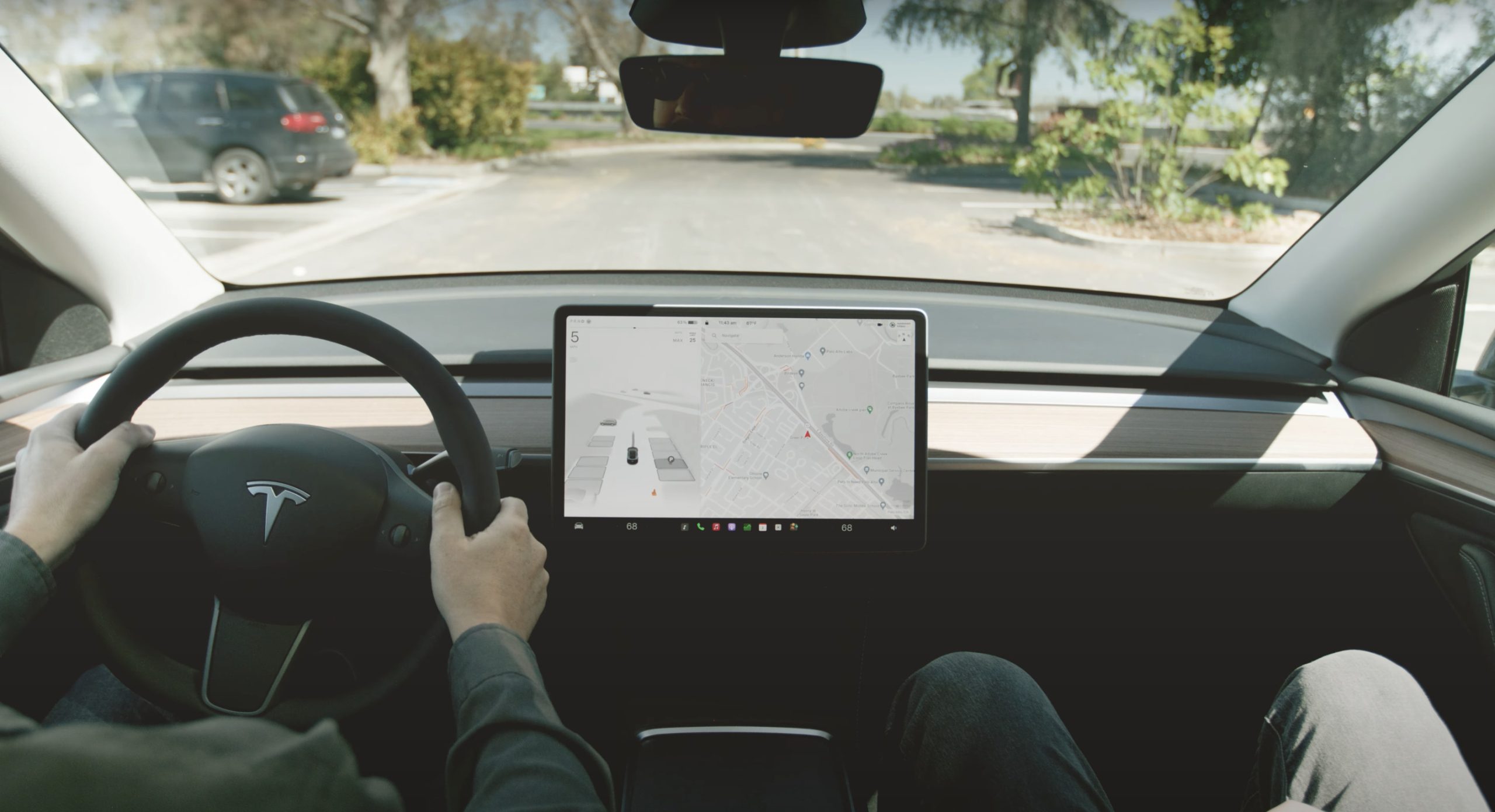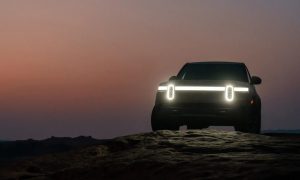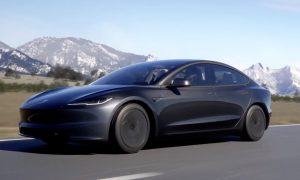

News
Drivers using ‘cooperative steering’ more likely to stay engaged: IIHS
A new study from the Insurance Institute for Highway Safety (IIHS) has highlighted the potential benefits to “cooperative steering” automated driving systems in keeping drivers engaged.
The study found that the likelihood a driver will remain engaged when driving with partially automated systems is higher when using “cooperative steering,” in which manual movements to the steering wheel don’t disengage the software, according to the study results shared in a press release on Tuesday. Inversely, those using partially automated systems that turn off when drivers use the steering wheel were less likely to take an active role.
“These results suggest that small differences in system design can nudge drivers toward safer habits,” said David Harkey, IIHS President.
This recent study looked at survey responses from 1,260 owners of vehicles from Ford, General Motors (GM), Nissan/Infiniti, and Tesla, who regularly use their partially automated driving systems.
Drivers who are used to partial automation that switches off when they try to share control over the steering were found to be less willing to steer or put their hands on the wheel in circumstances that required steering adjustments, while systems with some degree of manual steering were more likely to help drivers remain engaged with the road and take an active role when road scenarios demanded it.
Those with cooperative systems were ultimately 36 percent more likely than the others to say they would steer to one side of the travel lane when needed.
Drivers with vehicle systems that did offer shared control were 40 to 48 percent less likely than the others to say they would keep their hands off the wheel in situations that would make most drivers nervous, while two other recent IIHS studies showed that even those warned to remain engaged did not often do so.
Systems that remain on when drivers adjust steering include Ford’s BlueCruise system and Nissan/Infiniti’s ProPILOT Assist system, while both GM’s Super Cruise and Tesla’s Autopilot disengaged from lane-centering upon receiving driver steering inputs. While both the systems from Tesla and Nissan required drivers to keep their hands on the steering wheel, Tesla’s upgraded Supervised Full Self-Driving (FSD) allows some hands-free driving, and so do the aforementioned Ford and GM systems.
“Those are sizable differences,” said Alexandra Mueller, IIHS Research Scientist and Lead Author of the study. “Although there could be many reasons, one plausible explanation is that systems that switch themselves off whenever the driver steers may make drivers less likely to want to intervene, as it’s a pain to reactivate the system again and again.”
“These findings suggest that cooperative steering may have an implicit influence on how willing drivers are to take action when the situation calls for it, regardless of how they think their system is designed,” Mueller added.
You can see the full study results from the IIHS here.
RELATED: Tesla highlights FSSD safety in edge case test videos
Tesla’s Full Self-Driving Supervised and Cybercab unveil
The news comes weeks after Tesla unveiled its Cybercab robotaxi, which is built without a steering wheel, an accelerator, or brake pedals. It also comes in response to the company’s longtime bet on completely autonomous driving, first through the deployment of its FSD Supervised system, which is eventually expected to unlock an unsupervised version that buyers can use in their own vehicles.
While Tesla’s bet on full autonomy will likely come to fruition in future years, discussions about driver engagement have been ongoing, especially as those using Supervised FSD and other partially automated driving systems have used them in unintended ways that weren’t approved by the manufacturers.
At least for now, driver attention remains an important part of the path to full autonomy, until systems become safe enough to be trusted without supervision. Until then, efforts to keep drivers engaged may prove fruitful, and Tesla and others have taken steps to monitor drivers more closely when they use these systems, in order to ensure full engagement and readiness to regain control of the vehicle when needed.
What are your thoughts? Let me know at zach@teslarati.com, find me on X at @zacharyvisconti, or send us tips at tips@teslarati.com.
IIHS tested Tesla Autopilot safeguards: Here’s what they found


News
Tesla begins Robotaxi certification push in Arizona: report
Tesla seems serious about expanding its Robotaxi service to several states in the coming months.

Tesla has initiated discussions with Arizona transportation regulators to certify its driverless Robotaxi service in the state, as per a recent report from Bloomberg News. The move follows Tesla’s launch of its Robotaxi pilot program in Austin, Texas, as well as CEO Elon Musk’s recent comments about the service’s expansion in the Bay Area.
The Arizona Department of Transportation confirmed to Bloomberg that Tesla has reached out to begin the certification process for autonomous ride-sharing operations in the state. While details remain limited, the outreach suggests that Tesla is serious about expanding its driverless Robotaxi service to several territories in the coming months.
The Arizona development comes as Tesla prepares to expand its service area in Austin this weekend, as per CEO Elon Musk in a post on X. Musk also stated that Tesla is targeting the San Francisco Bay Area as its next major market, with a potential launch “in a month or two,” pending regulatory approvals.
Tesla first launched its autonomous ride-hailing program on June 22 in Austin with a small fleet of Model Y vehicles, accompanied by a Tesla employee in the passenger seat to monitor safety. While still classified as a test, Musk has said the program will expand to about 1,000 vehicles in the coming months. Tesla will later upgrade its Robotaxi fleet with the Cyercab, a two-seater that is designed without a steering wheel.
Sightings of Cybercab castings around the Giga Texas complex suggests that Tesla may be ramping the initial trial production of the self-driving two-seater. Tesla, for its part, has noted in the past that volume production of the Cybercab is expected to start sometime next year.
In California, Tesla has already applied for a transportation charter-party carrier permit from the state’s Public Utilities Commission. The company is reportedly taking a phased approach to operating in California, with the Robotaxi service starting with pre-arranged rides for employees in vehicles with safety drivers.
News
Tesla sets November 6 date for 2025 Annual Shareholder Meeting
The automaker announced the date on Thursday in a Form 8-K.

Tesla has scheduled its 2025 annual shareholder meeting for November 6, addressing investor concerns that the company was nearing a legal deadline to hold the event.
The automaker announced the date on Thursday in a Form 8-K submitted to the United States Securities and Exchange Commission (SEC). The company also listed a new proposal submission deadline of July 31 for items to be included in the proxy statement.
Tesla’s announcement followed calls from a group of 27 shareholders, including the leaders of large public pension funds, which urged Tesla’s board to formally set the meeting date, as noted in a report from The Wall Street Journal.
The group noted that under Texas law, where Tesla is now incorporated, companies must hold annual meetings within 13 months of the last one if requested by shareholders. Tesla’s previous annual shareholder meeting was held on June 13, 2024, which placed the July 13 deadline in focus.
Tesla originally stated in its 2024 annual report that it would file its proxy statement by the end of April. However, an amended filing on April 30 indicated that the Board of Directors had not yet finalized a meeting date, at least at the time.
The April filing also confirmed that Tesla’s board had formed a special committee to evaluate certain matters related to CEO Elon Musk’s compensation plan. Musk’s CEO performance award remains at the center of a lengthy legal dispute in Delaware, Tesla’s former state of incorporation.
Due to the aftermath of Musk’s legal dispute about his compensation plan in Delaware, he has not been paid for his work at Tesla for several years. Musk, for his part, has noted that he is more concerned about his voting stake in Tesla than his actual salary.
At last year’s annual meeting, TSLA shareholders voted to reapprove Elon Musk’s compensation plan and ratified Tesla’s decision to relocate its legal domicile from Delaware to Texas.
Elon Musk
Grok coming to Tesla vehicles next week “at the latest:” Elon Musk
Grok’s rollout to Tesla vehicles is expected to begin next week at the latest.

Elon Musk announced on Thursday that Grok, the large language model developed by his startup xAI, will soon be available in Tesla vehicles. Grok’s rollout to Tesla vehicles is expected to begin next week at the latest, further deepening the ties between the two Elon Musk-led companies.
Tesla–xAI synergy
Musk confirmed the news on X shortly after livestreaming the release of Grok 4, xAI’s latest large language model. “Grok is coming to Tesla vehicles very soon. Next week at the latest,” Musk wrote in a post on social media platform X.
During the livestream, Musk and several members of the xAI team highlighted several upgrades to Grok 4’s voice capabilities and performance metrics, positioning the LLM as competitive with top-tier models from OpenAI and Google.
The in-vehicle integration of Grok marks a new chapter in Tesla’s AI development. While Tesla has long relied on in-house systems for autonomous driving and energy optimization, Grok’s integration would introduce conversational AI directly into its vehicles’ user experience. This integration could potentially improve customer interaction inside Tesla vehicles.
xAI and Tesla’s collaborative footprint
Grok’s upcoming rollout to Tesla vehicles adds to a growing business relationship between Tesla and xAI. Earlier this year, Tesla disclosed that it generated $198.3 million in revenue from commercial, consulting, and support agreements with xAI, as noted in a report from Bloomberg News. A large portion of that amount, however, came from the sale of Megapack energy storage systems to the artificial intelligence startup.
In July 2023, Musk polled X users about whether Tesla should invest $5 billion in xAI. While no formal investment has been made so far, 68% of poll participants voted yes, and Musk has since stated that the idea would be discussed with Tesla’s board.
-

 Elon Musk1 week ago
Elon Musk1 week agoTesla investors will be shocked by Jim Cramer’s latest assessment
-

 Elon Musk21 hours ago
Elon Musk21 hours agoxAI launches Grok 4 with new $300/month SuperGrok Heavy subscription
-

 Elon Musk3 days ago
Elon Musk3 days agoElon Musk confirms Grok 4 launch on July 9 with livestream event
-

 News7 days ago
News7 days agoTesla Model 3 ranks as the safest new car in Europe for 2025, per Euro NCAP tests
-

 Elon Musk2 weeks ago
Elon Musk2 weeks agoA Tesla just delivered itself to a customer autonomously, Elon Musk confirms
-

 Elon Musk1 week ago
Elon Musk1 week agoxAI’s Memphis data center receives air permit despite community criticism
-

 Elon Musk2 weeks ago
Elon Musk2 weeks agoTesla’s Omead Afshar, known as Elon Musk’s right-hand man, leaves company: reports
-

 News2 weeks ago
News2 weeks agoXiaomi CEO congratulates Tesla on first FSD delivery: “We have to continue learning!”



















